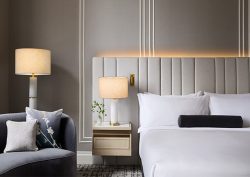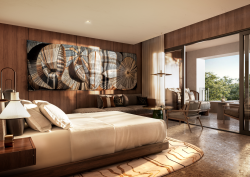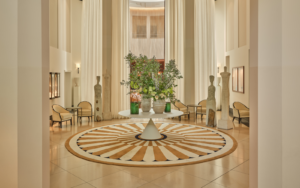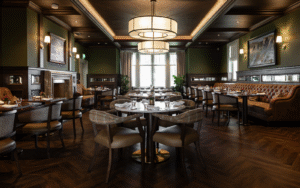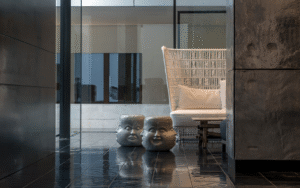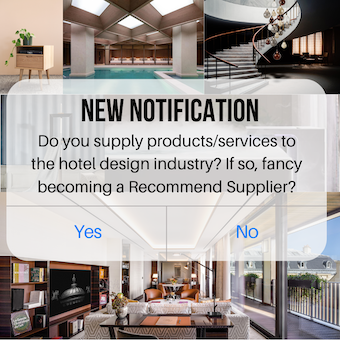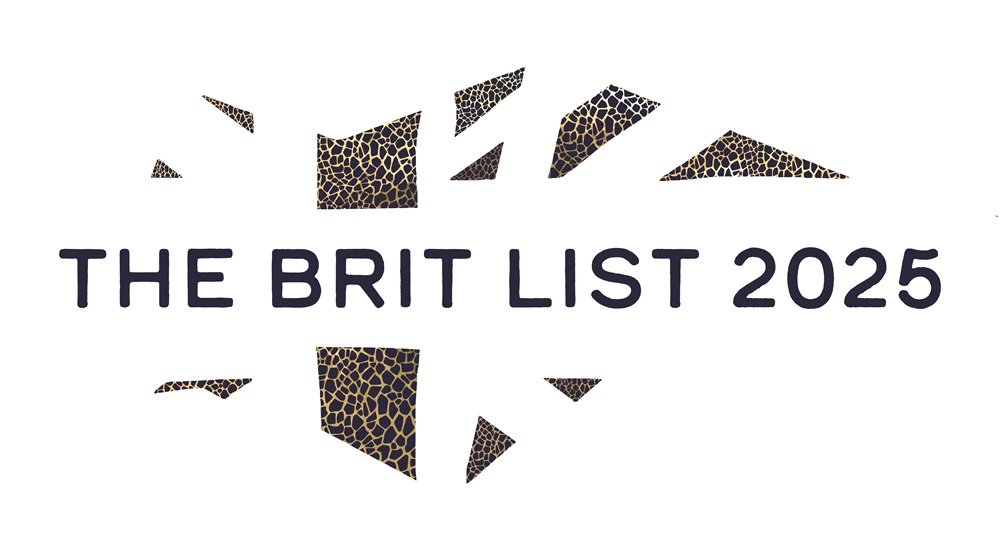From free flowing freedom to putting people back in a box, being a brand design director isn’t all soft furnishings and rainbows, as Hotel Designs found out during a recent panel session…

At HIX London 2024, seated incredibly comfortably on the Balsan and Ligne Roset stand in front of a packed crowd of eager listeners, Hotel Designs Editor Sophie Harper hosted an insightful panel discussion with Arun Rana, Design Director, Accor Hotels ENA; Grace Kelly, Design Director, Architecture, Design and Construction, Hilton EMEA; Henry Reeve, Director of Interior Design, IHG Hotels and Resorts; and Justin Meath Baker, Director of Interior Design, Hyatt EMEA, that delved into the creative and strategic decisions sculpting the current and future hospitality design landscape.
During the discussion, these heavyweight design directors each shared their invaluable perspective on hotel design, brand differentiation, and the ever important role and effect of hospitality design on guest experience — plus some bonus advice for designers on the pitching process too.
Heading up the design for brands that each manage upwards of 20 unique hotel lines, opening the conversation, Sophie Harper asked the panellists: what differentiates each brand?
“Each brand is different and has its own place. Each hotel’s design will even differ from region to region,” to adapt to the specific needs and expectations of various markets, explained Hilton’s Grace Kelly. “Just this week we have had renovation works at a DoubleTree by Hilton in Amsterdam,” she continued, “and we’ve been doing a lot of work with a Belgian company to bring fresh life to the DoubleTree brand, which has been around for 50 years now — so we have to be thinking about evolving it.”
The conversation then turned to the flexibility (or rigidness) of brand guidelines and whether these guidelines ever get in the way of design.
“Most of us will have technical standards that will be a common thread across all brands and it is up to us as project design directors to ensure that the design aligns with these,” said IHG‘s Henry Reeve. “Before designs get underway, I like to come together with all the different departments, such as operations etc, to have a conversation about what is required and how it can all align — to create a hotel design that is not only visually stunning but also user-friendly.”
Hyatt’s Justin Meath Baker added that the balance between creative freedom and adherence to brand guidelines can sometimes lead to challenging discussions, but that this is where the real challenge of being a designer lies: in creating something fresh and unique. Which is why strong relationships with suppliers is also key, agreed the panel.
The importance of collaboration with suppliers is often overlooked in hotel design, yet it plays such a critical role in the success of a project, implored Accor‘s Arun Rana, who highlighted how suppliers are often the unsung heroes of the design process who help to turn creative concepts into tangible products: “Interior designers come with the creative vision, but suppliers bring that vision to life.” A vision that, at least for our panel of design directors, begins with a pitch.
“We spend a lot of time researching designers and finding the right fit for each project,” said Grace, with designers selected based on their creativity, track record, and ability to deliver within the unique constraints of a project. Arun from Accor stressed the importance of tailoring pitches to the specific audience, as designers often present their ideas to a mixed group of stakeholders, including owners, budget-conscious decision-makers, and operators concerned with lead time, as well as the design directors.
The conversation also touched on the importance of energy and passion in a pitch. Henry noted that the best pitches are concise and passionate, emphasising that designers should not waste valuable time focusing on minor details but should instead convey their vision in a way that resonates with their audience, which Arun illustrated by recalling a pitch where a designer used scent to engage the senses and create a memorable impression.
Justin passionately advocated once again to designers to strive for the Avant Garde in their designs, which will create that memorable impression: “If I have to push you, its going the wrong way. I want you (the designers) to be going so far out there, doing something so ridiculous that I have to be the bad guy — Mr Negative — that brings you back to reality.”
“So what is the future of design?” Asked Sophie, to which Justin responded “the unknown — and the unseen.”
Rounding off what had been an Easter Egg filled discussion, questions were received from the audience. No doubt influenced by Justin’s poetically enigmatic description of design’s future, a member of the audience asked the directors where they see AI taking the industry.
Expressing mixed opinions about the role of technology, Arun — admitting that AI was a subject he didn’t want to discuss in the session — answered: “AI tools are useful, much like Pinterest, but they are yet to be fully integrated into the design process. Though I have no doubt that one day there will be an AI Management role in studios, much like there is now a Sustainability Manager.”
However, Arun did criticise AI-generated designs for lacking the human touch and depth of experience that comes from real-world experience. “The best source of inspiration is travel — getting out there and experiencing things first-hand. Your interior design inspiration probably won’t come from the last interior that you saw, but maybe from a market you visited, or the food you ate, or the aromas you scented.” Though Grace added that AI can prove useful in specific contexts, such as when her team used the technology to illustrate design elements, such as pillars, in the early stages of a DoubleTree project when physical mock-ups were not yet possible.
In conclusion, the talk provided a fascinating glimpse into the complexities of hotel design from the insiders’ perspective, from the challenges of balancing creativity with brand consistency to the importance of collaboration between designers, suppliers, and operations teams. As the industry continues to evolve, it is clear that the future of hotel design will be driven by innovation (human or otherwise…), the push for unique guest experiences, and the ongoing quest to create spaces that surprise, inspire, and make people want to return.
Balsan and Ligne Roset are both Recommended Suppliers and regularly feature in our Supplier News section of the website. If you are interested in becoming one of our Recommended Suppliers, please email Katy Phillips.




